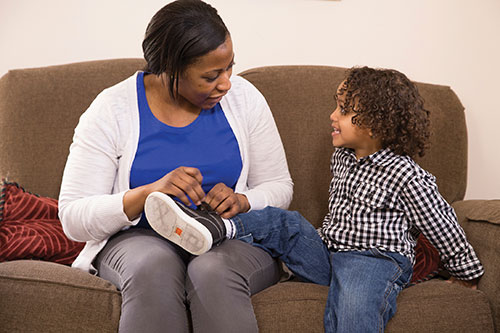Time-In: Providing Positive Time for Your Child
 Imagine if your boss or spouse ignored your expected or positive behaviors and focused only on your negative behaviors?
Imagine if your boss or spouse ignored your expected or positive behaviors and focused only on your negative behaviors?
Just as you find it enjoyable to hear positive words or praise from your spouse, boss, co-workers or friends, your children enjoy hearing positive words and praise from you.
Time-In is an important first step in developing an effective discipline system and building a healthy relationship with your child. Time-In occurs anytime you give your child positive attention. As parents, we sometimes have a tendency to overlook our children's appropriate behavior in favor of addressing or redirecting behavior we perceive to be negative. When this happens frequently, children learn that engaging in disruptive behavior may be the quick and easy way to get their parents' attention. Although it is important to address negative behaviors with redirection or consequences, parents also have to provide Time-In so children learn what behavioral choices are appropriate. Time-In is your easy way to catch your child being good and teach him or her how to get your attention in positive ways.
Use Time-In When Your Child:
- Plays quietly instead of disturbing you with demands of attention
- Follows an instruction the first time you give it instead of being told several times
- Shares a toy instead of grabbing one from another child
- Asks for something politely instead of whining
- Accepts “No" for an answer instead of throwing a temper tantrum
- Waits his or her turn to talk instead of interrupting someone else
- Completes a chore or uses a social skill you've taught
 Ways to Use Time-In:
Ways to Use Time-In:
- Give a thumbs-up
- Say “Good job!"
- Give a high-five
- Say “Nice work!"
- Give your child a pat on the back or head
- Say “I like how you…."
- Smile or wink
- Use the words “Great," “Excellent," “Fantastic" or “Super" to describe your child's good behavior
- Give your child a kiss or a hug
You also can make sure your child has plenty of Time-In by joining him or her in activities like reading books, going to the park, taking a walk or playing a game.
By using Time-In frequently and consistently, your child will come to understand that it's more fun and more pleasant to get your attention by doing things you want him or her to do rather than by doing things you want to discourage.
Additional Resources
-
Help! There's a Toddler in the House! by Thomas M. Reimers, Ph.D.
-
I Brake For Meltdowns: How To Handle The Most Exasperating Behavior Of Your 2- To 5-Year-Old by Michelle Nicholasen and Barbara O'Neal
-
Parenting the Strong-Willed Child: The Clinically Proven Five-Week Program for Parents of Two- to Six-Year-Olds by Rex Forehand and Nicholas Long
Download Printable Version
Kid Tips;Discipline
